The Square Neck Dobro

A wonderful attribute of being a guitar player is the ability to stretch our playing abilities, as well as our sound texture, by learning additional stringed instruments. This used to be called doubling or tripling.
Knowledge of the guitar is actually knowledge of the fret board, and how the interrelation of finger technique and string creates sound. This basic knowledge can be transferred to other members of the stringed instrument family. Knowing the fret board provides a platform allowing the guitar player to “more easily” move from guitar, to 12-string guitar, to bass, to mandolin, to violin, to baritone guitar, and to Square Neck Dobro.
I believe that a guitarist who doubles on another instrument becomes a better guitarist.
A limited knowledge and the ability to play a few songs or a solo on a second stringed instrument teaches the guitarist about melody, tone and the nature of music itself.
We can often become lost and isolated in the world of the guitar. Discovering a second stringed instrument breaks loose old practice habits, offers something new and unusual to practice, and provides that “WOW” factor on stage.
A perfect example of a possible additional instrument for the guitarist is the Square Neck Dobro.
Square Neck Dobro is a generic term for a resonator guitar, which has a neck shaped like a two by four piece of wood. This is played by laying the guitar body across the knees in the seated position. A Square Neck is open tuned, usually in “G” (gbdgbd), has a very high action, and is fretted by using a variety of square or rounded steel bars.



Most players of this instrument use metal (or plastic, or any combination thereof) thumb and fingerpicks on the right hand. Strumming or finger picking is accomplished with the same method used for a regular acoustic guitar, with a slight adaptation to the horizontal position across the lap.
The interesting part of the Square Neck Dobro is the usage of the steel bar for fretting chords or single melody lines. This instrument offers the ability to do either in an open tuning, with the limitations inherent in that tuning, of course. For example, in open G tuning, standard minor chords are difficult to obtain easily. However, striking root elements of the difficult chord, or combining a drone and melody note, often covers the situation — especially in a group setting.
I came to the Square Neck Dobro not through its usual styles of primitive country music, bluegrass or “Americana,” but in a search for tone textures for my new CD, The Cultivation of Grace.
I was searching for a specific, swampy, spooky, Southern American tone for one of the cuts, Georgia Nights, and happened to pick up a Johnson Square Neck in a music store. I was easily hooked. The overriding sound texture of the Square Neck is a ringing, slide tone with a high timbre very different from bottleneck slide guitar. Its tone and texture are unmistakable and, although not usable universally on every song, the tone may be that irreplaceable element you’ve been looking for.
The “sliding” nature of chords and notes on the Square Neck allows you to play behind the beat of the music, incorporating another unique element in your music.
I’ve used the Square Neck as both melody and rhythm instrumentation on Cultivation of Grace. Those who may be interested can pull up an mp3 of Georgia Nights at www.guitar9.com to hear how, with no background on the instrument and a little bit of study, an average guitar player was able to incorporate the Square Neck. I also employed standard bottleneck guitar in conjunction with the Square Neck. You can clearly hear the differences between the tonalities of the instruments.
Some may be hesitant to buy a Square Neck Dobro due to fear of a new instrument or cost factors.
The Square Neck appeared to me to be very user friendly as long as one kept the proper perspective and enjoyed the learning curve. In very few practice sessions, one could be picking out simple melody lines such as Amazing Grace, and begin obtaining the feel for usage of the bar and the slide technique for basic major chords. However, learning the Square Neck is not a matter of replacing guitar playing technique or styling.
Still, in a relatively short period of time, I was using the Square Neck in gigging with my band Local Fourcast on specific numbers. It added a wonderful touch to our tone.
In relation to consumer costs, the Square Neck Dobro is available through many of the Korean importers of guitars, such as Johnson, Samick, and the like, for a cost comparable to a student guitar. One must incorporate into the costs a bar and the usage of special, but not overly expensive, Dobro strings. To complete the picture, multiple beginners’ how-to videos are available for the Square Neck, which really do assist the guitarist in playing this unique instrument.
I realize that the guitar alone could be enough of a challenge for anyone. I look toward comparable stringed instruments as means for making practice fun, and as wonderful methods to provide changes to your personal sonic palette. And, last but not least, such instruments are windows into the greater world of music and its relationship to the guitar.
Besides, you never know when that special band is looking for the person who can play guitar, mandolin, Square Neck, baritone guitar, octave mandolin, and …
About the Author
Warren started playing and teaching the guitar in his teens. He did the usual club circuit and left it all to become a policeman. After ten years of this, Warren became a counter-terrorism agent. Following about a decade of that, he retired back into civilian life and, in one of life’s strange, unexplainable moments, he became a guitarist again.
